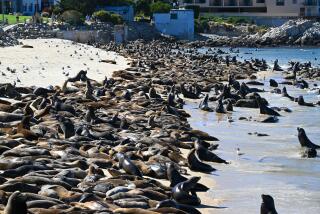Another Home for the Sea Otter
- Share via
Hundreds of thousands of sea otters frolicked along the Pacific Coast until fur hunters decimated the ranks of Enhydra lutris Nereis in the 19th Century. Today about 1,400 otters survive along the California coast from north of Monterey to Morro Bay. The otter is designated as a threatened species, and the U.S. Fish and Wildlife Service is obligated to take action to protect it.
The greatest threat is that a massive oil spill would hit the sea otter’s habitat. Unlike other marine mammals, the otter has no insulating layer of blubber, but is buffered from the cold ocean water by an unusually dense underfur. Even a partial coating with oil would destroy this protection, and the animal would die of hypothermia.
The Fish and Wildlife Service is proposing to create a new colony of otters on San Nicolas Island, the outermost of the Channel Islands, so that the otter would survive even if the coastal population met with disaster. Seventy otters a year, up to a total of 250, would be transplanted to San Nicolas, 62 miles offshore. The plan has the support of Congress, Friends of the Sea Otter, the staff of the state Fish and Game Department and others.
The sea otter is one of nature’s most appealing creatures, and one would not expect the plan to cause controversy. But the otter thrives on shellfish, primarily abalone and sea urchins, so it competes with commercial and sport fishermen.
Thus fishing groups are expected to oppose the plan when it goes before the California Fish and Game Commission for approval on June 24 and the California Coastal Commission on July 7. The shellfish catch at San Nicolas Island, valued at an estimated $350,000 a year, could be eliminated in about five years.
But the fishing industry would receive a tradeoff that is even more important over the long run: creation of otter-free zones that would prevent the coastal otter population from migrating southward and into far richer fishing grounds. Any otter found moving into the these areas would be caught and returned to its former habitat.
This seems reasonable. The proposal for a second colony has been studied and debated since 1971, and has broad support. The Fish and Game and Coastal commissions should have no difficulty in ratifying this well-considered and worthy project.
More to Read
Sign up for Essential California
The most important California stories and recommendations in your inbox every morning.
You may occasionally receive promotional content from the Los Angeles Times.













